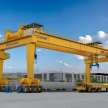
In the dynamic landscape of industrial material handling, the reliability and performance of overhead cranes play a pivotal role in the efficiency of various operations. Among the critical factors influencing the design and capabilities of these cranes is the concept of duty cycle. For double girder overhead cranes, understanding the duty cycle is essential to ensuring that these workhorses meet the demands of diverse applications with precision and endurance. In this article, we embark on a journey into the world of duty cycles, unraveling their significance and impact on the operational prowess of double girder overhead cranes.
Defining Duty Cycle in the Context of Overhead Cranes
Duty cycle, in the realm of overhead cranes, refers to the ratio of active operating time to the total time, expressed as a percentage. It provides insights into how frequently and intensively a crane is expected to perform within a given time period. The duty cycle classification guides the crane's design, ensuring that it is engineered to withstand the specific demands of its intended application.
Understanding Duty Cycle Classifications
Duty cycle classifications are categorized based on the nature and intensity of crane usage. The classifications typically include:
1. Light Duty (S1): Light-duty cranes are designed for sporadic or occasional use with relatively low load capacities. They have a low duty cycle, often characterized by short operating periods and extended periods of inactivity. Light-duty cranes are suitable for applications where precision and careful handling are paramount.
2. Moderate Duty (S2): Moderate-duty cranes are engineered for more frequent use compared to light-duty cranes. They operate with a higher duty cycle, featuring a balance between active and inactive periods. These cranes are suitable for moderate-load applications with consistent, albeit not continuous, usage.
3. Heavy Duty (S3): Heavy-duty cranes are designed for demanding applications with frequent and continuous operation. They have a higher duty cycle, making them suitable for scenarios where heavy loads need to be lifted, transported, and positioned with regularity. Heavy-duty double girder overhead cranes are often found in industrial settings such as manufacturing plants and steel mills.
4. Severe Duty (S4): Severe-duty cranes are engineered for continuous and intensive operation under harsh conditions. They have the highest duty cycle classification and are capable of handling near-constant loads in challenging environments. Severe-duty cranes are employed in critical applications where robustness and endurance are paramount.
Implications of Duty Cycle on Double Girder Overhead Cranes
Understanding the duty cycle is crucial when selecting, designing, or operating double girder overhead cranes. The duty cycle directly influences several key aspects of crane performance and longevity.
1. Structural Integrity: The duty cycle classification dictates the structural requirements of the crane. Heavy-duty and severe-duty cranes, designed for more frequent and continuous use, demand a robust structure to withstand the stresses associated with regular lifting and movement of heavy loads.
2. Mechanical Components: Components such as the hoist, trolley, and end trucks are selected and designed based on the anticipated duty cycle. Heavy-duty and severe-duty applications may require components with enhanced durability, precision, and load-bearing capacities to ensure reliable performance over extended periods.
3. Heat Dissipation: Intensive operation generates heat within the crane's electrical and mechanical components. Duty cycle considerations influence the design of systems for effective heat dissipation, ensuring that the crane can operate safely without risking overheating or component damage.
4. Power Requirements: The duty cycle affects the power requirements of the crane. Cranes with higher duty cycles may necessitate more robust power systems, including motors and control mechanisms, to meet the demands of continuous operation.
5. Maintenance and Inspections: The duty cycle classification influences the recommended maintenance and inspection schedules. Cranes with higher duty cycles may require more frequent and comprehensive inspections to identify and address wear and tear promptly, ensuring optimal performance and safety.
6. Operational Efficiency: Matching the duty cycle to the application ensures operational efficiency. Choosing a crane with an appropriate duty cycle classification prevents underutilization or overuse of the equipment, optimizing productivity and minimizing the risk of premature wear.
Selecting the Right Duty Cycle for Specific Applications
Choosing the appropriate duty cycle for a double girder overhead crane involves a careful assessment of the operational requirements and environmental conditions. Here are key considerations when selecting the right duty cycle:
1. Frequency of Use: Evaluate how frequently the crane will be in operation. If the crane is expected to handle heavy loads continuously, a higher duty cycle classification such as heavy-duty or severe-duty may be warranted.
2. Load Characteristics: Consider the nature of the loads to be lifted. If the crane will handle varying loads with different weights and dimensions, the duty cycle should align with the demands of these diverse applications.
3. Environmental Factors: Assess the environmental conditions in which the crane will operate. Severe-duty cranes are designed to withstand challenging environments, including exposure to extreme temperatures, dust, humidity, and corrosive substances.
4. Operational Duration: Determine the expected duration of crane operation during a specific time period. Cranes with higher duty cycles are better suited for applications where continuous or near-continuous operation is required.
5. Safety Considerations: Prioritize safety considerations when selecting a duty cycle. A crane that operates within its specified duty cycle is more likely to deliver reliable performance and minimize the risk of unexpected failures or breakdowns.
Conclusion: Sailing Smoothly with the Right Duty Cycle
In the intricate dance of industrial material handling, the duty cycle of double girder overhead cranes emerges as a silent orchestrator, guiding the design, performance, and longevity of these vital machines. Matching the duty cycle to the specific demands of the application ensures that the crane operates with precision, reliability, and efficiency.
As industries evolve and operational demands intensify, the role of duty cycle classifications becomes increasingly pivotal. Whether navigating the challenges of a heavy-duty manufacturing environment or delicately handling loads in precision applications, the duty cycle stands as a beacon, guiding the design and operation of double girder overhead cranes on their journey through the seas of industrial excellence.
About the Creator
Aicrane01
Welcome to the Aicrane Blog, your practical guide to lifting solutions. Discover articles covering overhead cranes, gantry cranes, winches, steel structures, boat lifts, and more.
Website: https://steelmillcranes.com/






Comments
There are no comments for this story
Be the first to respond and start the conversation.